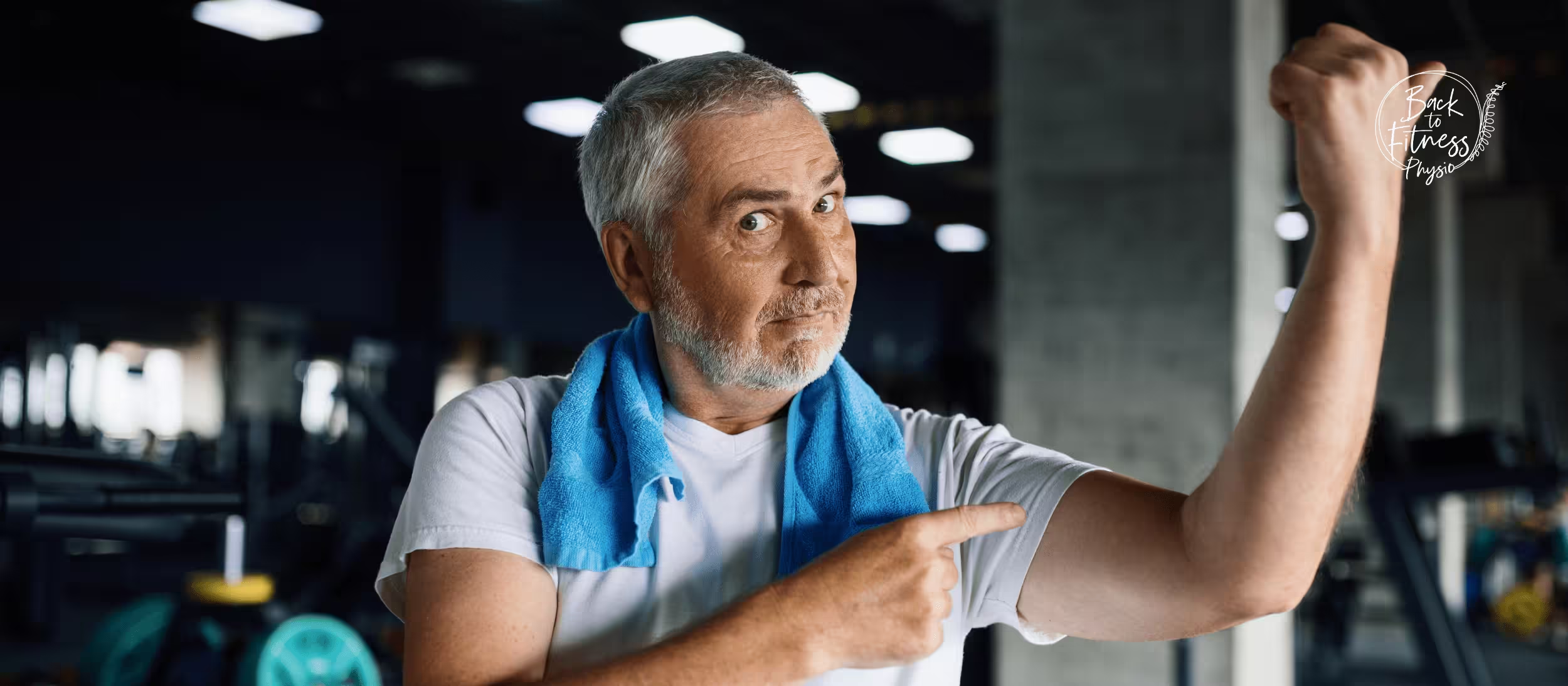Strength Training for Over 40s
Ever heard the saying ‘life begins at 40?’ Well, here at Back at Fitness, we’re all for an empowered approach to ageing.
Think of this way: entering a new decade of your life is the perfect chance to not only embrace your evolving body, but also appreciate how hard it works to keep you moving.
In this blog, we’ll be covering:
- Does strength training help after 40?
- Is strength training good for menopause?
- The benefits of strength training for over 40s
- The best exercises for over 40s
- Key takeaways
There’s a common misconception that getting older means strength training is suddenly off the table (God forbid someone over 40 dares to lift a dumbbell *rolls eyes*).
But we’re here to tell you that getting fit at 40 is where it’s at.
Curious to learn more about fitness for older adults? We can get to the core of this. Keep reading for our expert’s insight on strength training and the (literally) life changing benefits that come with it.
Does strength training help after 40?
It sure can! Our team has helped countless clients aged 40 and above feel confident in their fitness journey. We’ll create a bespoke plan to fit your age, ability, and flexibility so that you can reap the benefits of strength training.
Here’s how weight bearing exercises can support people aged 40 and above:
Combats frailty and weakness
While it’s easy to assume frailty is a reason to not practise resistance training, the reality is quite the opposite. Exercising a few times a week can increase strength and stability – both of which improve overall quality of life.
Preserves independence
Being able to do everyday activities without assistance is something we all take for granted – until the day comes when we’re no longer able. Getting ahead with strength training can help to preserve your ‘future you’s’ vitality – something you’ll no doubt thank yourself for.
Reduced age related diseases
Osteoporosis, heart disease, type 2 diabetes… these conditions all have one thing in common: they can develop with age. Combining bone strengthening benefits with improved cardiovascular health and controlling blood sugar, regular resistance training has been shown to manage all three diseases.
Promotes better sleep
Studies have shown that adding strength training into your weekly workouts can give you 40 minutes extra shut eye each night. That’s because it promotes adenosine production (a chemical that helps you fall asleep quicker), allowing for more restful nights that lead to energised days.
Minimises muscle loss
As we age, it’s perfectly normal to become less mobile than we once were. You might be running slower, lifting lighter, or experience slower recovery times after exercising – all of which can zap the motivation to move. But with professional guidance from a physiotherapist, strength training can keep you going from strength to strength – regardless of your age.
Is strength training good for menopause?
Women spend a staggering 30% of their lives being postmenopausal. But don’t worry! With the right exercise plan, you can take back control. Working on muscle maintenance is key for relieving the mental and physical impact changing hormones can have – and cardio along won’t cut it.
The benefits of strength training exercise for menopause include:
Increases bone density
While postmenopausal women can become osteopoenic/osteoportic over time, the right exercises can maintain and even improve bone density.
Maintains muscle mass
Strength loss can be 15% per decade after 50 – but don’t let that scare you! Incorporating strength training into your weekly routine can help to maintain muscle mass for a stronger ‘you’.
Boosts metabolism
One major bonus of strength training? It burns body fat… even when you’re resting (yep). Studies have shown that your metabolism keeps ticking for up to 38 hours post workout – perfect for a sustainable weight loss programme.
Improves the mood
We all know exercising can release endorphins (AKA ‘happy hormones’) in the brain, and strength training is no exception. As well as this, it also helps to boost confidence while forming a deeper connection with your body.
What are the best (and easiest) exercises for over 40s?
So, that’s the science part covered. Now it’s time to get physical!
The beauty of strength training is that you don’t need to have an expensive gym membership or a room of fancy equipment to practise. Sure, these things can come in handy, but there are plenty of ways to incorporate weight bearing exercises into your everyday routine – without even having to leave the house.
Here are our top five moves for your 40s and beyond. Start with the easier ones and then work to ability.
As always, the most important thing is to ensure your form is correct. The last thing you want to do is cause more harm than good. For peace of mind, always consult a professional before proceeding and take the time to stretch to avoid injury.
1. Squat
Squats aren’t just here to give you a perkier peach, they can also help to reduce the risk of knee and ankle injuries. The more you do, the stronger the bones and ligaments will be. It’s a win win!
Starting with your feet hip distance apart and slightly turned out feet – ensuring your heels stay firmly on the ground. With a straightened back, send your hips backwards as if you were sitting on an imaginary chair. Bend your knees to the lowest point available to you, then use your heels to stand up again.
Easy version: sit to stand from a chair.
2. Pull-ups
From combating mom posture and sculpting your back and shoulders, pull-ups are an ideal move improving endurance. If you can access a pull-up bar, it’s well worth incorporating this move into your workout routine.
With your hands shoulder-width apart from each other, grab an overhand grip of a pullup bar. If it’s too high up, simply use a box to elevate you. On an exhale, lift your feet from the ground until you’re hanging from the bar. Pull your shoulder back and down then engage your arm and back muscles. Bend your elbows and raise your upper body up towards the bar, taking care to ensure your shoulder blades stay back. When at the top, inhale and extend your arms until you’re back to the starting position.
Easy version: Use a resistance band to do a rowing action whilst standing.
3. Press up
As well as working your chest, press ups are super effective for targeting the triceps and core muscles. Practise these for improved upper body strength and increased definition.
Begin in a plank position with your feet hip-width apart. Create a triangle shape with your fingers by turning them inward and engage your core to keep your neck and back aligned. With your elbows bent, move your head as close to the floor as you can. Pause, then push yourself back up. When your arms are straight again, you’ve done your first rep!
Easy version: Press up against a wall or on a table.
4. Deadlift
Known for their ability to improve hip mobility and build muscle in your quads, abs, and glutes, deadlifts are a favourite for us physiotherapists for good reason!
Ground your feet firmly into the floor and stand tall, pulling up your weight of choice with straightened arms. Bring your hips forward and tighten your upper abs and glutes, then slowly bring it back with knees bent, before pushing your bum behind to put the weight back on the floor.
Easy version: Pick shopping bags off the floor.
5. Romanian deadlift (RDL)
RDL’s are great for strengthening the posterior chain muscles (think glutes, hamstrings, and adductors), core, and lower body – all big ones for keeping things in check!
Stand on one leg with the knee slightly bent and a kettlebell in both hands. Hinge at the hip and push your bum backwards with a flat back (your weights should be at hinge height here). With a strong core, push through your heel to stand, ensuring the weights stay close to your shins as you move. Pause, squeeze your glutes, and repeat.
Easy version: Balance on one leg
Key takeaways
We hope this blog has helped you to feel empowered to try a new fitness regime – regardless of your age, gender, or ability. Since we’ve covered quite a lot, here’s some final points to take with you:
- An effective strength training programme should always be adapted to suit you, not the other way around.
- Working with a physiotherapist is key for ensuring your workout will 1) work for your individual needs and 2) minimise the risk of injury.
- Strengthening exercises don’t need to be intense. Instead, consistency is key to making a positive impact on how you feel.
- The idea that lifting weights doesn’t work for people over 40 is a myth. With the right programme, you can build and maintain muscle for a better quality of life.
- As well as the physical benefits, strength training can provide a great mental boost to improve your confidence, bodily connection, and sleep quality!
Ready to take the next steps?
Now you’ve exercised your brain, you might have a few questions on how to exercise your body. Feeling stuck on where to start? We’ve got your back.
Feel free to get in touch with our team of physio’s today to get the (fitness) ball rolling!

